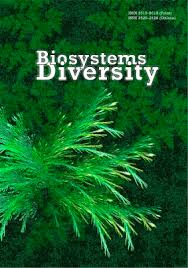Co-infection of Trichuris vulpis and Toxocara canis in different aged dogs: Influence on the haematological indices
Co-infection of Trichuris vulpis and Toxocara canis in different aged dogs: Influence on the haematological indices
Author(s): I. V. Saichenko, A. A. Antipov, T. I. Bakhur, L. V. Bezditko, S. S. ShmayunSubject(s): Health and medicine and law, Sociobiology
Published by: Дніпропетровський національний університет імені Олеся Гончара
Keywords: Nematoda; Trichuridae; Ascarididae; parasites; canine; blood parameters;
Summary/Abstract: Trichuris vulpis and Toxocara canis are worldwide parasitic nematodes affecting dogs and mammals of the Canine family. Due to the special structure of the shells, the eggs of these geohelminths can maintain their viability in soil, sand, water and the environment for a long time. The study involved young (6–12 months old) and adult (1.5–8.0 years old) dogs affected by co-infection of T. vulpis + T. canis; the control group consisted of dewormed healthy animals of the same age. Parasitological examination of dogs' faeces was performed using a "Counting Chamber for Ovoscopic Researches"; morphological parameters, indicators of nutrient metabolism, mineral metabolism and activity of enzymatic systems were determined in blood and serum. According to the results of parasitological research on the dogs, it was found that young animals are more prone to toxocarosis, and adults – trichurosis. The co-infection of nematodes T. vulpis + T. canis in dogs develops several changes in haematological parameters: a significant decrease in erythrocytes, haemoglobin, MCV, MCH, and haematocrit, leukocytosis with basophils and eosinophilia in young infected animals; and eosinophilia and basophilia (15.9 times) in adults, compared with healthy dogs of the same age. Among the changes in serum biochemical parameters, young infected dogs showed a decrease in the concentration of total protein and albumin content, an increase in the content of "acute phase" proteins (α-1, α-2 and β-globulins), an increase in cholesterol and total bilirubin; in adult infected dogs, a decrease in albumin content, an increase in the content of α-1, α-2, and β-globulins, an increase in the concentration of cholesterol and total bilirubin, a decrease in the concentration of urea in comparison with healthy animals were determined. Also, among the indicators of mineral metabolism, a decrease in the concentration of calcium and magnesium in the serum was found in young infected dogs. Among the changes in the enzyme metabolism in the serum of infected dogs, there was an increase in the activity of all studied enzymes in animals of both research groups: ALT, AST, α-amylase, GGT and ALP. Thus, co-infection with nematodes T. vulpis + T. canis has a complex pathogenic effect on the body of dogs of all ages, which manifested itself in multiple changes in haematological parameters. In the future, the authors’ team plan to develop comprehensive measures to combat nematode infections in different living conditions of dogs, taking into account the results of the current research.
Journal: Biosystems Diversity
- Issue Year: 29/2021
- Issue No: 2
- Page Range: 129-134
- Page Count: 6
- Language: English

